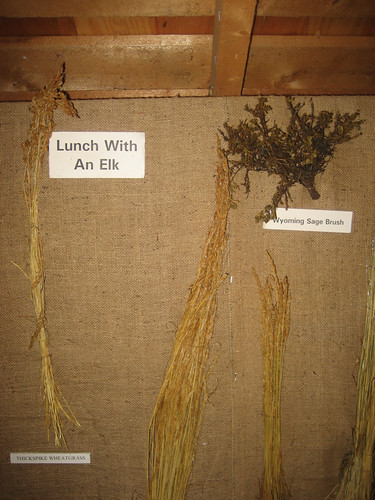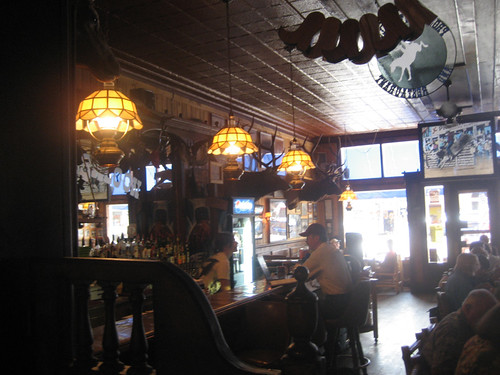
When I first saw that Michael Pollan had written a ten-zillion-page opus on the state of cooking, eating, the Food Network, Julie and Julia, and other such weighty topics, my first thought was that this was way, way too much to read onscreen; Pollan has written a piece about how our lives are too busy for cooking, at a length that our lives are too busy to read.
My second thought was, I’m about to spend ten zillion hours in the car going to and from Wyoming, so I’ll print it out.
And so I wound up reading a foodie manifesto during perhaps the least foodie week of my year, in the least foodie place I can remember going to in just about my entire life. I mean, Wyoming is a marvelous and beguiling place to visit in many ways, a state where they bother to put up population signs for towns with two-digit populations (if only someone in Emblem had died right before they put the sign up, I might have seen a one-digit one) and then follow it with a sign announcing the local cattle rustling heritage museum (every town seems to have a museum of something that happened between 1870 and 1900).
But as far as food culture goes… in terms of restaurants, it’s pretty much, where do you want to eat a preformed hamburger patty and frozen fries today? Apart from a smattering of Mexican and Chinese (no part of America is bereft of those), that’s pretty much it; when a shopkeeper in Cody asked my wife where she was from, the name “Chicago” immediately prompted a five-minute lament on the state of what little Italian food there is in Wyoming, which basically concluded with the axiom that Italian food gets steadily worse from the Rockies on. (To judge by the Jersey-in-1957-amber menu of the place down the street from him, he knows whereof he speaks.)
This made Wyoming an interesting context for considering Pollan’s points, which are roughly these: We may celebrate Julia Child as the progenitor of food TV and our foodie culture, but actually our modern food TV is her antithesis, great at encouraging us to watch more and more hyped up food-sports shows, but largely discouraging our own venturing into the kitchen to do anything more than assemble processed junk a la Sandra Lee—and her advertisers. We have the food TV we have because it suits the world of processed foods we live in, where no one has time to really cook and the habit itself is rapidly being lost.
As a market researcher sums it up (in the best quote in the piece), “A hundred years ago, chicken for dinner meant going out and catching, killing, plucking and gutting a chicken. Do you know anybody who still does that? It would be considered crazy! Well, that’s exactly how cooking will seem to your grandchildren: something people used to do when they had no other choice. Get over it.”
So cooking has become a niche pastime, like quilting or radio controlled aircraft. Yet niches can occupy pretty big territory sometimes, and after a week in Wyoming I came away convinced that they can even cover entire states.

It’s not that processed foods weren’t all over Wyoming— in restaurants, as I said. But restaurants are scarce enough outside major tourist stops that it’s clear this is one state where people don’t eat out every night. Meanwhile, go into a grocery store and, sure, amid the frozen dinners and Lunchables and Kleenex-brand sandwich bread, there’s a surprising amount of natural, organic and just old-fashioned real stuff being sold even in very small towns. (A lot more than I’d bet you could find in towns five times as large in Illinois.) Somebody in Wyoming is certainly cooking better than you can eat out in all but the largest and wealthiest tourist-oriented towns like Jackson.
And the proof of that for me was certainly that several of my better meals were in little cafes which seemed to be no more than an extension of the proprietor’s home— not that they were objectively great, but that they were usually the most real, the least prefab, the ones that seemed the most rooted in a local housewifely sense of how to make things as opposed to drones following the instructions on the Sysco box.
In short, Wyoming seems to be one of the last outposts of the old food culture— before the processing that Pollan decries, but also, before the heroine whose legacy he celebrates. Maybe those two events are not as opposed as we assume.
* * *
The standard narrative, which Pollan seems to assent to, casts Julia Child as the great liberator of the American home cook— even as American cooking began declining right as she appeared on the scene.
True, she gave status to the act of cooking at a crucial moment for American women— but look at how she did it: by encouraging us to abandon American cookery for French technique. Far from championing American cooking (like her fellow West Coasters James Beard or Alice Waters), by the time she really turned to her life’s work she was a classic eastern establishment WASP trying to lead the masses toward European tastes and sophistication.
And to be honest, can you really say she succeeded? She tried to teach us French; we all learned Italian instead. Part of the reason Julie Powell’s blog project was such a novelty is precisely because so many people own Child’s Mastering the Art of French Cooking… and so few ever crack it open now.
What’s more, to the extent she has had an influence, hers was a pivotal step in turning cooking from something you did well for the sake of others at your table, to something you do for self-expression. And the problem with turning cooking into a Me Decade pursuit, like jogging or meditation, is that it’s no longer necessary— it’s just something to be done when you feel like it.
It’s telling that the only woman in 21st century America who actually cooks every night is doing it for her blog, not her husband— and that she’s therefore remarkable enough to warrant a movie about her strange lifestyle. Child set out to teach America how to cook a better cuisine, but on a certain level the message America took away was that its native cookery was inferior—and thus not worth the effort being put into it. Or the effort it would take to pass it to the next generation.

Partly as a result, preparing food became a self-conscious act, and American cookery ceased being our indigenous cuisine and became just one more concept. It’s easier to accept the artifice in processed foods when it’s all an act anyway; in a true beef culture, Wyoming hamburger stands would pride themselves on handformed fresh beef as a matter of principle. But when hamburger stands are about fitting the concept of a hamburger stand, all that matters is that you carry off the concept convincingly. If the meat’s a little worse, play the oldies a little louder; it will average out.
Now, I don’t mean to lay every box of T.G.I. Friday’s Frozen Jalapeno Cheese Poppers at Child’s feet. Obviously the main reason Americans stopped cooking is because both sexes are working now, and working more, and the time just isn’t there. But that lifestyle change also owes something to the feminist movement telling housewives to throw off their chains and find their real meaning at a desk rather than a stove. The chain of American cooking passed from mother to daughter broke in the 1960s, and if the most influential food personality of the decade didn’t have something to do with it, who did?
Ironically, it’s precisely the meaninglessness of her boring desk job that drives Julie Powell to find meaning by taking up cooking, discovering in it all the things that corporate bureaucracy lacks— tactile pleasures, finality followed by a fresh start the next day, instant feedback, real appreciation. She turns to Julia Child to help rescue her from a less satisfying life without realizing the irony that Child is part of how she got stuck there in the first place.



 If you like this post and would like to receive updates from this blog, please subscribe our feed.
If you like this post and would like to receive updates from this blog, please subscribe our feed.




